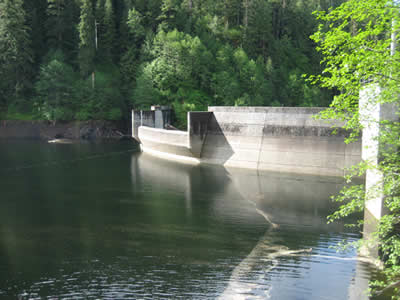
Drought put a strain on Southeast Alaska’s hydroelectric power generators. The agency that supplies electricity to Ketchikan, Petersburg and Wrangell said recently it won’t raise its rates to compensate — at least not yet.
Southeast Alaska is something of a green energy paradise. Most large communities like Ketchikan, Sitka and Juneau get more than 90 percent of their electricity from hydroelectric dams. That’s one advantage of living in the world’s largest temperate rainforest.
But when the wettest parts of Alaska start to dry up, things change. During a 16-month drought that only ended this past November, Southeast communities had to turn to diesel to fill the gap left by underfilled hydroelectric lakes.
That’s bad news for consumers and the environment: diesel is both dirty and expensive. But if you run a regional hydropower agency, it’s especially bad news
The Southeast Alaska Power Agency, or SEAPA, maintains two major hydropower reservoirs in southern Southeast: Swan Lake and Tyee Lake. It’s a publicly-owned power wholesaler — it sells its hydroelectric power to utilities in Ketchikan, Wrangell and Petersburg. Those communities supplement with locally-owned hydropower and bill consumers. It’s a way for the three towns to share costs.
But what happens when a region that relies on consistent rainfall to generate electricity is struck by drought?
SEAPA CEO Trey Acteson says the drought meant the agency couldn’t sell as much power over the past two years. Acteson says revenues generally come in between $10 million and $12 million. But last year, the agency only took in a little more than $9 million.
The agency has reserves to make up the difference — for now — but Acteson says more dry weather would be bad news for SEAPA.
“Any prolonged drought would be would be pretty significant,” Acteson said in a Friday interview.
SEAPA’s expenses don’t necessarily decrease when the agency can’t sell its hydroelectric power — engineers, accountants and landlords still have to get paid, whether it’s raining or not. But that’s not all.
“We spend probably on average about $3 million a year just in capital reinvestment into the projects to maintain reliability and availability,” Acteson said.
And it’s not just maintenance — an underwater cable connecting Petersburg to SEAPA’s Tyee Lake recently failed.
“That might be seven to $8 million,” Acteson said.
So in SEAPA’s 2020 budget, Acteson proposed raising the wholesale power rate by half a cent — a 7 percent bump. That would have been the first rate increase in SEAPA’s 22-year history.
But, in a Dec. 12 meeting, the proposal went nowhere. Board Member Bob Lynn, a Petersburg assemblyman, said his community was staring down a $9 million project to improve local hydroelectric facilities. He says a recent study found that Petersburg would have to raise consumer rates by 14 percent to pay for the project.
Lynn acknowledged that SEAPA certainly had to raise its rates to keep up with expenses, but he took issue with the fact that the proposal came out less than a week before the board meeting. He said he might be willing to reconsider when the board meets next year.
“But if I walk in there right now, everything’s going to fall apart,” Lynn said during the SEAPA board meeting. “So where I’m going, bottom line is, I can’t agree today to a rate increase.”
Board members from Wrangell and Ketchikan expressed similar concerns.
The board unanimously voted down the proposed half-cent increase.
But Acteson says SEAPA is going to have to raise rates soon.
“Otherwise you aren’t able to fund the capital improvement program and then you start having failures and the result is a lot more expensive,” he said.
Acteson says he’ll bring the proposal back to the board when it meets again in July.
“It just gives everybody a chance to adjust their programs and processes and their budgeting and stuff to minimize the impact on the ratepayers,” he said.
Acteson says he thinks the board will approve a rate increase in July, but until then, he says SEAPA has enough reserves to make it through the first half of 2020 on solid financial footing. That is, of course, unless it stops raining again.
This story was produced as part of a collaboration between KRBD and Alaska’s Energy Desk.








